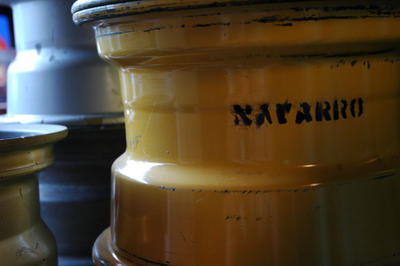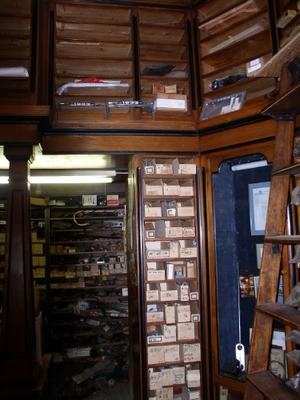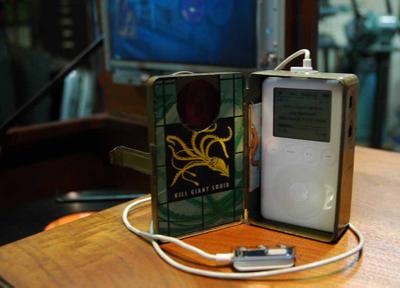
If you haven't checked out Coop's site in a while, you should. Totally fascinating blow by blow of a painting coming together. It appears to be alot of work.


 I bought the stack of wheels. All magnesium, most knock-off style. The set of yellow wheels were on Barney's Indy entry. One of those wheels is marked Ferrari. Who knows how Barney ended up with one Ferrari Grand Prix knock-off magnesium wheel, but there it is. So, I guess I have to build a race car.
I bought the stack of wheels. All magnesium, most knock-off style. The set of yellow wheels were on Barney's Indy entry. One of those wheels is marked Ferrari. Who knows how Barney ended up with one Ferrari Grand Prix knock-off magnesium wheel, but there it is. So, I guess I have to build a race car.



 Everybody's asking, what with the pinball machine, Make welding article and giant ipod, where are the heavy metal, dirty fingernail, gritty car projects for which Hooptyrides became famous? Progress is the natural enemy of having 1000 active projects.
Everybody's asking, what with the pinball machine, Make welding article and giant ipod, where are the heavy metal, dirty fingernail, gritty car projects for which Hooptyrides became famous? Progress is the natural enemy of having 1000 active projects.




 Hemmings Motor News is the absolute cornerstone of automobile passion. Printed on newsprint, packed to the gills with teeny advertisements, hyperbole abounds and thick as a phone book making the September Vogue look like a mere pamphlet. I like to imagine that there is a more obsessive person in the world than myself. Some sort of cigar chomper that reads it front to back, every word, every Bantam, Autolette and Packard ad examined and absorbed.
Hemmings Motor News is the absolute cornerstone of automobile passion. Printed on newsprint, packed to the gills with teeny advertisements, hyperbole abounds and thick as a phone book making the September Vogue look like a mere pamphlet. I like to imagine that there is a more obsessive person in the world than myself. Some sort of cigar chomper that reads it front to back, every word, every Bantam, Autolette and Packard ad examined and absorbed.

 Use to be a time when a fellow could ship some hogs to Portland, get a Buick dealership, order six cars, print up some giant embossed aluminum business cards and open the finest garage in the West. We always thought Hooptyrides was the finest garage in the West but after seeing this operation, I am not so sure. Note the Buick, Dodge Brothers or Peerless automobile going in the west side of the building and a similar vehicle exiting on the east side.
Use to be a time when a fellow could ship some hogs to Portland, get a Buick dealership, order six cars, print up some giant embossed aluminum business cards and open the finest garage in the West. We always thought Hooptyrides was the finest garage in the West but after seeing this operation, I am not so sure. Note the Buick, Dodge Brothers or Peerless automobile going in the west side of the building and a similar vehicle exiting on the east side.LIND, CARL (C. E.)That clip reads like a damn novel! March 19 six Buicks arrive, a week later Carl sets a record drive from Salmon River and he begins constructing a car repair garage two weeks later. What did you do this month?
Twin Falls, shipping hogs to Portland. 1/22/09-5 Visited Buhl. 1/22/09-8 1/29/09-11 Has agency to sell Buick cars. 2/19/09-8 Buick article. 3/19/09-7 Six Buicks arrive; purchased Alcazar rink building for garage. Will also open hardware store in Boyd building. 3/26/09-5 Record run home from Salmon River; 36 miles in 1-1/4 hours. 4/09/09-1 Constructing garage for car repair. 4/23/09-5 Planning new store. 6/4/09-5 Stock arriving. 7/16/09-5 New hardware store opened. 7/30/09-5 In Buhl. 12/24/09-4

 The big ipod turned out to be more popular than anything previously Hooptyrides. Integration of high tech hardware into an old radio cabinet more interesting than junk cars? Hard to imagine.
The big ipod turned out to be more popular than anything previously Hooptyrides. Integration of high tech hardware into an old radio cabinet more interesting than junk cars? Hard to imagine.

 Perhaps the finest automotive archive ever, this extremely generous fellow covers the Japan autoscene for almost 20 years. The main page is here, the gallery here. His profile is just more question marks for westerners, so I will call him tanetane92, based on the URL. I got sucked in by the 2005 Tokyo Auto Salon photos that feature ridiculous vehicles like this ivory turd, but the true gold is not in the arena, but outside in the parking lot.
Perhaps the finest automotive archive ever, this extremely generous fellow covers the Japan autoscene for almost 20 years. The main page is here, the gallery here. His profile is just more question marks for westerners, so I will call him tanetane92, based on the URL. I got sucked in by the 2005 Tokyo Auto Salon photos that feature ridiculous vehicles like this ivory turd, but the true gold is not in the arena, but outside in the parking lot. I hadn't blogged it earlier, because where do you even start? And why isn't there an adirondack chair on that front porch?
I hadn't blogged it earlier, because where do you even start? And why isn't there an adirondack chair on that front porch?

 The first sensible aftermarket exhaust tip I have seen.
The first sensible aftermarket exhaust tip I have seen. Awwwww! Let's get asphixiated, baby!
Awwwww! Let's get asphixiated, baby!
 Think you have seen it all? Not impressed by giant fiberglass spoilers and exhaust tips that reach for the stars? Well, you are truly good and dead if you are able to resist the art trucks section of tanetane92's archive of Japan transportation.
Think you have seen it all? Not impressed by giant fiberglass spoilers and exhaust tips that reach for the stars? Well, you are truly good and dead if you are able to resist the art trucks section of tanetane92's archive of Japan transportation. While in Japan, I saw more sedate versions of these Main Street Electrical Parade mega-trucks and thought they would make the ultimate mobile bar. Broadcast a pirate FM radio station message with the back alley location, arrive with the lights off and flip the switch as you open the rear doors to reveal a clearance light encrusted semi-truck trailer secret bat cave bar!
While in Japan, I saw more sedate versions of these Main Street Electrical Parade mega-trucks and thought they would make the ultimate mobile bar. Broadcast a pirate FM radio station message with the back alley location, arrive with the lights off and flip the switch as you open the rear doors to reveal a clearance light encrusted semi-truck trailer secret bat cave bar!

So, that was a mistake. But you know, I always like to bum rush the show and just, you know, jump in, get electrocuted, what have you. When I disassembled the scoring wheels, I was able to free them up so they are operating again. The Captain still doesn't 'know' the wheels are reset and a pair of relays still oscillate wildly behind the backglass as the scoring motor runs and runs. I need to stop waiting to find a schematic in the trash.
Note that pinball machines are generally "dry lube" devices - any solenoid
in it shouldn't be lubricated.
do NOT use contact cleaner on EM games! it is a formula for diaster. i have seen several games BURN all the under playfield wiring due to contact cleaner. i also know a guy that burnt his ball hair because he was working on an EM in his boxers, sprayed contact cleaner on the score motor, put down the playfield, turned it on, and BOMB! coin door burst open with flame burning his nard hair.What's next? Nude welding? I'll be keeping my contact cleaner in the cabinet and my pants on.
 Everybody's asking, didn't you case mod an Ipod previously? Yes. And I blogged it. But, since I am a cheap and easy hustler, I will again. Worth an update as I have a better camera now and it is topical as it was just in Wired magazine. Not with a credit or anything, but it is there.
Everybody's asking, didn't you case mod an Ipod previously? Yes. And I blogged it. But, since I am a cheap and easy hustler, I will again. Worth an update as I have a better camera now and it is topical as it was just in Wired magazine. Not with a credit or anything, but it is there.



